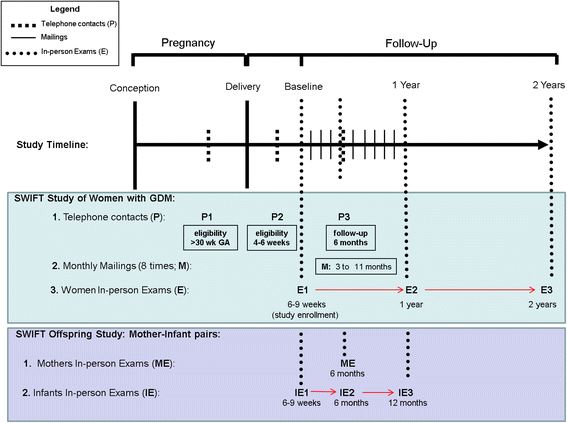The study of women, infant feeding and type 2 diabetes after GDM pregnancy and growth of their offspring (SWIFT Offspring study): prospective design, methodology and baseline characteristics
- PMID: 26177722
- PMCID: PMC4504097
- DOI: 10.1186/s12884-015-0587-z
The study of women, infant feeding and type 2 diabetes after GDM pregnancy and growth of their offspring (SWIFT Offspring study): prospective design, methodology and baseline characteristics
Abstract
Background: Breastfeeding is associated with reduced risk of becoming overweight or obese later in life. Breastfed babies grow more slowly during infancy than formula-fed babies. Among offspring exposed in utero to maternal glucose intolerance, prospective data on growth during infancy have been unavailable. Thus, scientific evidence is insufficient to conclude that breastfeeding reduces the risk of obesity among the offspring of diabetic mothers (ODM). To address this gap, we devised the Study of Women, Infant Feeding and Type 2 Diabetes after GDM Pregnancy and Growth of their Offspring, also known as the SWIFT Offspring Study. This prospective, longitudinal study recruited mother-infant pairs from the SWIFT Study, a prospective study of women with recent gestational diabetes mellitus (GDM). The goal of the SWIFT Offspring Study is to determine whether breastfeeding intensity and duration, compared with formula feeding, are related to slower growth of GDM offspring during the first year life. This article details the study design, participant eligibility, data collection, and methodologies. We also describe the baseline characteristics of the GDM mother-infant pairs.
Methods: The study enrolled 466 mother-infant pairs among GDM deliveries in northern California from 2009-2011. Participants attended three in-person study exams at 6-9 weeks, 6 months and 12 months after delivery for infant anthropometry (head circumference, body weight, length, abdominal circumference and skinfold thicknesses), as well as maternal anthropometry (body weight, waist circumference and percent body fat). Mothers also completed questionnaires on health and lifestyle behaviors, including infant diet, sleep and temperament. Breastfeeding intensity and duration were assessed via several sources (diaries, telephone interviews, monthly mailings and in-person exams) from birth through the first year of life. Pregnancy course, clinical perinatal and newborn outcomes were obtained from health plan electronic medical records. Infant saliva samples were collected and stored for genetics studies.
Discussion: This large, racially and ethnically diverse cohort of GDM offspring will enable evaluation of the relationship of infant feeding to growth during infancy independent of perinatal characteristics, sociodemographics and other risk factors. The longitudinal design provides the first quantitative measures of breastfeeding intensity and duration among GDM offspring during early life.
Figures
References
-
- Dabelea D, Pettitt DJ. Intrauterine diabetic environment confers risks for type 2 diabetes mellitus and obesity in the offspring, in addition to genetic susceptibility. J Pediatr Endocrinol Metab. 2001;14:1085–91. - PubMed
Publication types
MeSH terms
Grants and funding
LinkOut - more resources
Full Text Sources
Other Literature Sources
Medical
Miscellaneous


